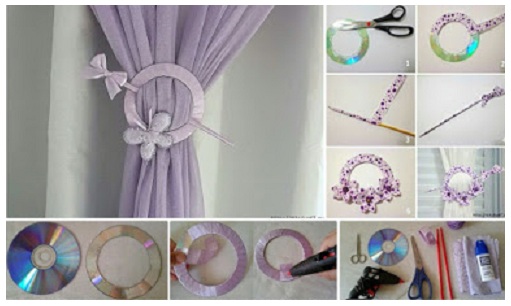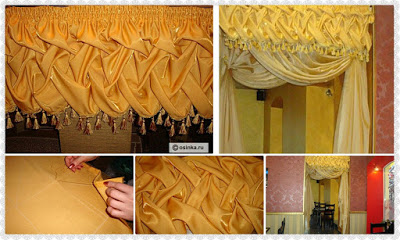You can make your own hands holder curtains of unnecessary CD drive. Here a small tutorial. Contents can be to your taste.
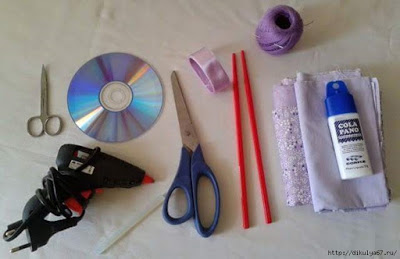
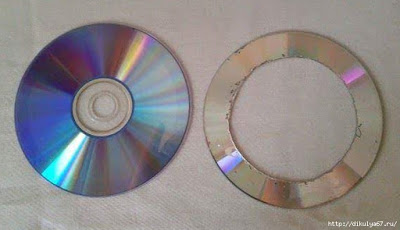




How to make fancy curtains
First, you must select the fabric for curtains tailoring. Beautifully will look fabric with metal overflow. Well look contrasting transitions in tone.
In the present master class puffs sewn on the cornice of 1.3 m. For this you need a piece of fabric at a ratio of one to two, or 1 to 2.5 relative to the length of the cornice.
 We eaves length 1.3 m – needs a piece of fabric 3.25 +0.5 (allowance at side seams), only 3.3 m.
We eaves length 1.3 m – needs a piece of fabric 3.25 +0.5 (allowance at side seams), only 3.3 m.
In width:
• 0,65 m 3-band (as in the diagram), the height of product in finished form 0.45 m;
0.83 m • 4-band products in finished form height 0.55 m;
• 1,01 m-5 strips off the shelf height 0.65 m.
Learn, please scheme. See photos.
 he harvested tissue peruse for defects, check the length and width, steamed iron.
he harvested tissue peruse for defects, check the length and width, steamed iron. The sides of the future curtains See photos.
The sides of the future curtains See photos.  For comfortable work and avoid errors, you need to make patterns out of cardboard.
For comfortable work and avoid errors, you need to make patterns out of cardboard.
1. №1 = 8 cm (6 cm – width webbing + 1 cm seam tape+ 1 cm volume)
2. №2 = 18 cm;
3. №3 = 15 cm. 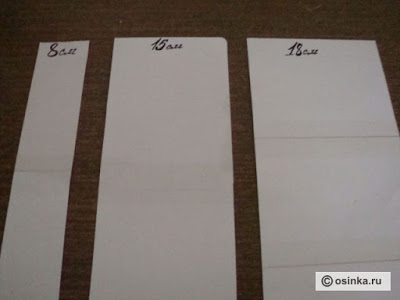 Choose a place where we are going to create your masterpiece. Ideal – a large table. It decompose and flatten stripped cloth. The fabric should lie face down.
Choose a place where we are going to create your masterpiece. Ideal – a large table. It decompose and flatten stripped cloth. The fabric should lie face down.
Take the mold 8 cm wide (№1) applying it to the upper tissue slice.  Now, take the curve №2 (width 18 cm), apply to have the line drawn by again drawing a line along the entire length of our fabric. Repeat this process three times. We have to be parallel to the line width: 8 cm, 18 cm, 18 cm, 18 cm
Now, take the curve №2 (width 18 cm), apply to have the line drawn by again drawing a line along the entire length of our fabric. Repeat this process three times. We have to be parallel to the line width: 8 cm, 18 cm, 18 cm, 18 cm  Take curve №3, we are putting any of the side seams and perpendicular lines to the already drafted. We get the mesh.
Take curve №3, we are putting any of the side seams and perpendicular lines to the already drafted. We get the mesh.  To make it convenient to work in the cells draw a diagonal, as shown in the photo.
To make it convenient to work in the cells draw a diagonal, as shown in the photo. 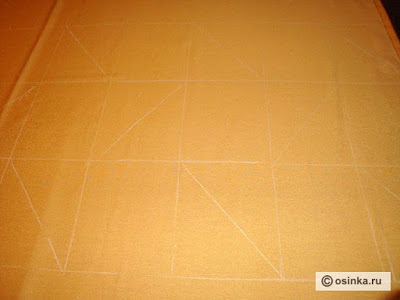 Take the needle and thread in tissue tone, and at the cell diagonally fasten the first puff.
Take the needle and thread in tissue tone, and at the cell diagonally fasten the first puff.  Stitches tacks do five – six times.
Stitches tacks do five – six times. 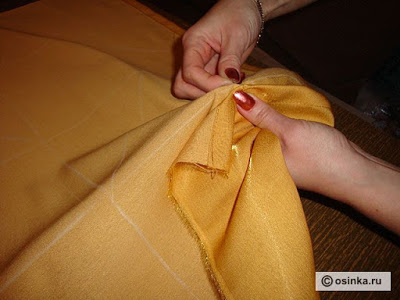 Secure all puffs for this series.
Secure all puffs for this series. 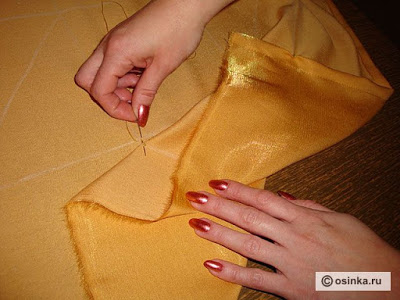 The next series begin to fix on the side where you’ve finished the first row whip. Follow the scheme.
The next series begin to fix on the side where you’ve finished the first row whip. Follow the scheme. 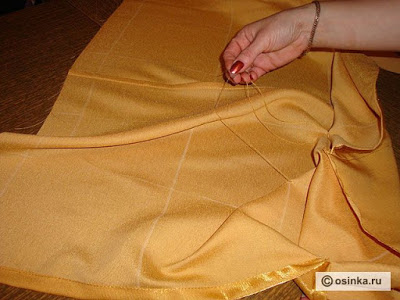 Third row starts where finished second whip. And so all the rows under the scheme. Be careful.
Third row starts where finished second whip. And so all the rows under the scheme. Be careful.  This is the result of the first phase of your work. The truth is impressive?
This is the result of the first phase of your work. The truth is impressive?  The bottom of the curtains in our master class we will process the fringe. In fact, the methods of processing weight: seam in the hem, processing piping, lace, beads …
The bottom of the curtains in our master class we will process the fringe. In fact, the methods of processing weight: seam in the hem, processing piping, lace, beads …
like fabric, you need to advance to steam and smooth 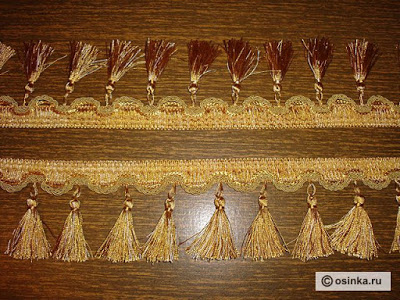 We are putting a fringe to the bottom edge of the curtains. We combine slices. Fabric and fringe wrong side together. Sew,
We are putting a fringe to the bottom edge of the curtains. We combine slices. Fabric and fringe wrong side together. Sew,  Now, gently loosen the fringe on the front side. Do this for the entire length of the edge of the fringe and paving machines line.
Now, gently loosen the fringe on the front side. Do this for the entire length of the edge of the fringe and paving machines line.  Bottom curtains ready. Look inside out – it’s perfect.
Bottom curtains ready. Look inside out – it’s perfect. 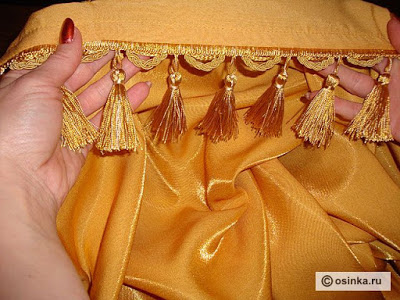 It remains to handle the upper section of the curtains. Take special braid for processing top curtains. Put them to the wrong side of each other. Pre-need to hem curtains and braid 1 cm. Sew their machine stitching.
It remains to handle the upper section of the curtains. Take special braid for processing top curtains. Put them to the wrong side of each other. Pre-need to hem curtains and braid 1 cm. Sew their machine stitching. 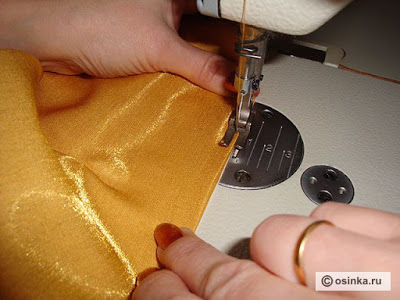 Lay the second parallel line is strictly for lace center. Line lay on the front side. The ends of the thread carefully hide.
Lay the second parallel line is strictly for lace center. Line lay on the front side. The ends of the thread carefully hide.  Run the same parallel line on the edge of the tape. Gently pull the fabric by hand.
Run the same parallel line on the edge of the tape. Gently pull the fabric by hand.  Contractible four strands to braid. Puffs acquire a very different kind.
Contractible four strands to braid. Puffs acquire a very different kind.  And then, finally, the result of work. Beauty, is not it?
And then, finally, the result of work. Beauty, is not it?  So, this curtain looks in the doorway.
So, this curtain looks in the doorway. 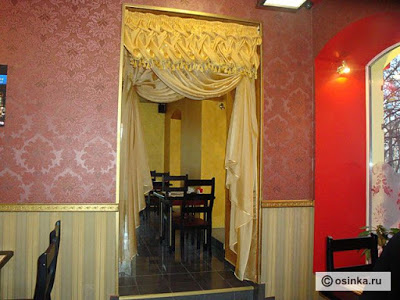
The original curtains on the door knit “Orange Heart”
Need for knitting:
– Yarn Pekhorka “Successful”, 100% mercerized cotton, 220m / 50g, orange – 3 pieces;
– Acrylic beads in the shape of hearts, “Crystal game” art.CRP061, orange – 8 packages;
– Glass beads 9-11 mm;
– Hook number 1.25.

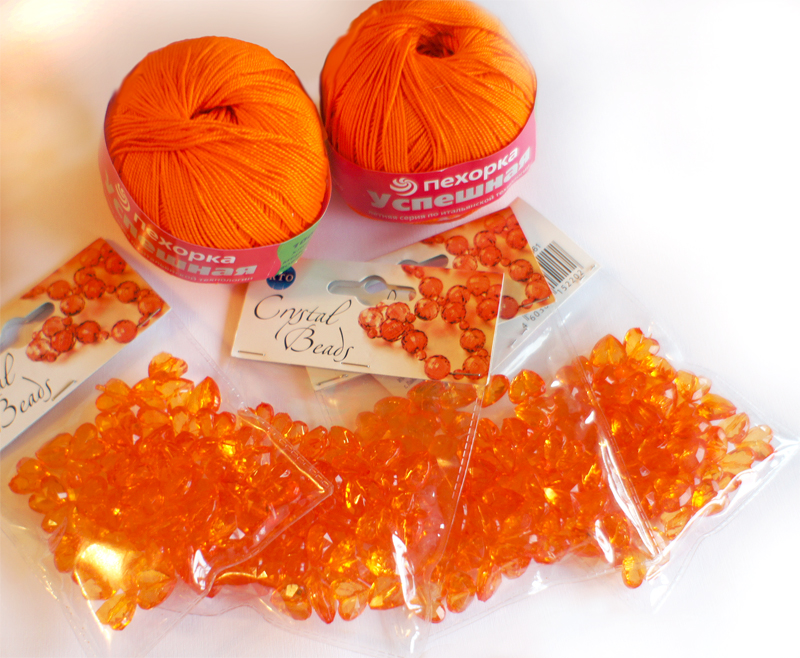
Legend:
ce – air loop;
st b / n – column without nakida;
v s / n – bar with nakida.
So, we begin:
Knitting curtains can be divided into 2 stages: Knitting and Knitting yarns top.
I prefer to knit the upper hand in the width of doors, ie from one casing to another – it’s easier not to miss the desired width curtains. Very well suited for this Bruges braid.
Top curtains knit in 2 threads.
For knitting lace Enter 7 CP – The base tape – we assume that this is the first row.
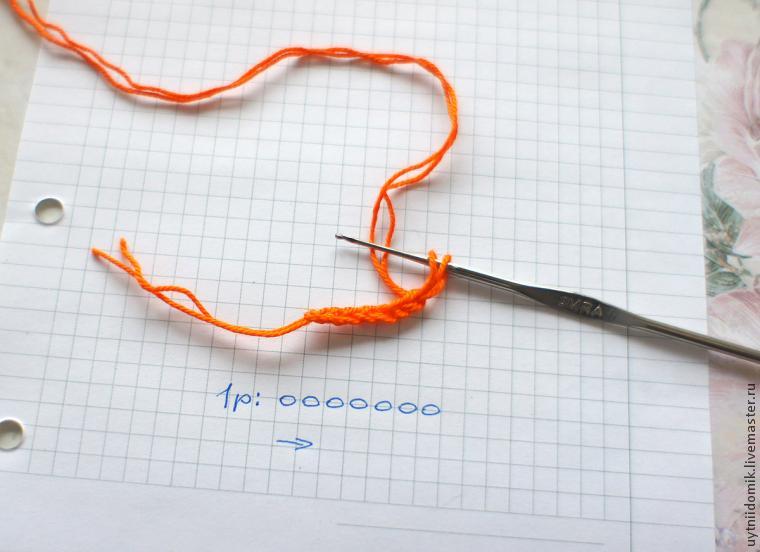 2 row: knit 6 CP – “Ears”, for which we tie the thread – and v s / n in the 7th ce
2 row: knit 6 CP – “Ears”, for which we tie the thread – and v s / n in the 7th ce Thence and 5 v s / n.
Thence and 5 v s / n.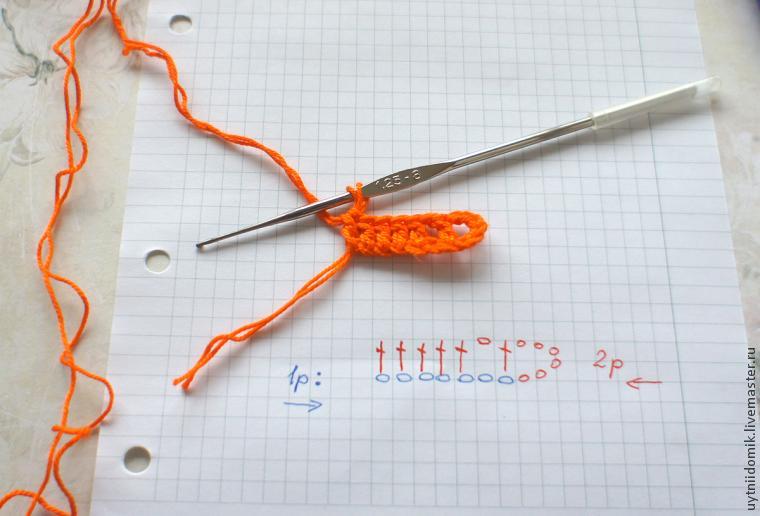 3 series of 12 ce ( “ear” for which the curtain will be hung on the door), turn over knitting, Article 5 s / n, CP, arts / n.
3 series of 12 ce ( “ear” for which the curtain will be hung on the door), turn over knitting, Article 5 s / n, CP, arts / n.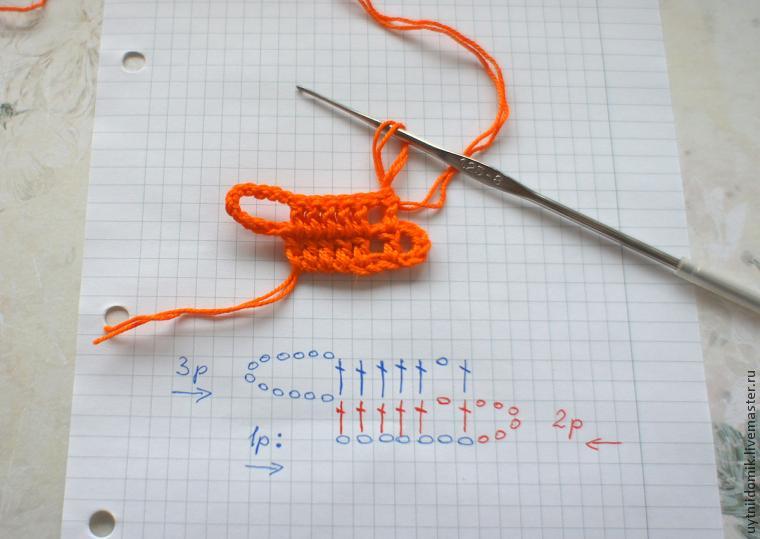
If you already have a crossbar, which will be hung curtains, you should not knit 12 cm, and so to be able to thread the bar into the “ear”.
Row 4: knit as the second.
 Row 5: knit, as the third.
Row 5: knit, as the third.
We continue to knit braid, alternating between the second and third rows of curtains to the desired width. Cut the strings, tails hide.
According to the “lugs” consider how to associate the threads and how much beads and glass beads.Glass beads are tied and hung on the ends of the threads – so the thread is better to hang and less confused. And in order to determine how much you need Beads – knit pattern. I was knitting yarn with different amounts of CE between the beads and different lengths and is applied to the door. As a result, I decided that between the beads is 40 ce and beads on each strand is 7 pcs.
curtains yarns knit in a single thread.
Before you start knitting each thread stringing beads – 7 pieces.
 Move aside the beads away, so they do not interfere with undergirding the ball and start to trim. We type 2 CE and the second loop on the hook 6 item b / n – 1 number.
Move aside the beads away, so they do not interfere with undergirding the ball and start to trim. We type 2 CE and the second loop on the hook 6 item b / n – 1 number. 2 number: 2 item b / n in each column – get 12 st b / n.
2 number: 2 item b / n in each column – get 12 st b / n.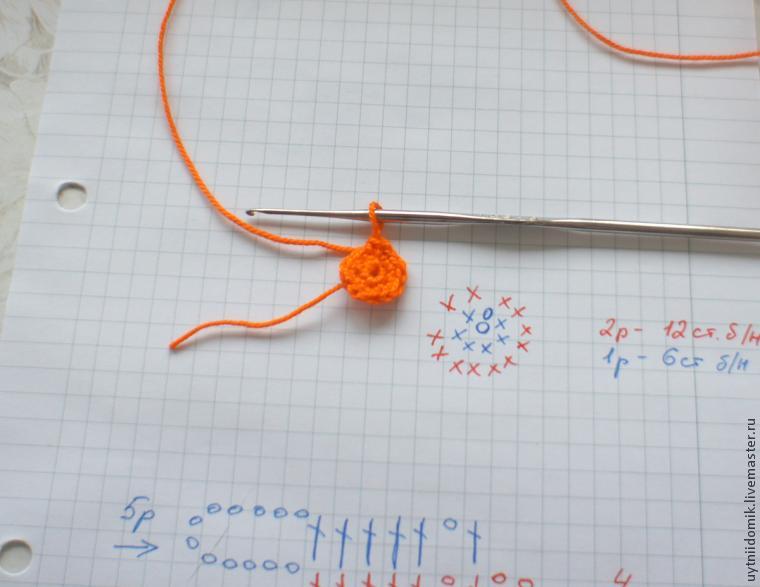 3rd row: Art w / o, 2 tbsp w / n in a column – so continue until the end of the series and get a 18 st b / n.
3rd row: Art w / o, 2 tbsp w / n in a column – so continue until the end of the series and get a 18 st b / n. It’s time to try on the ball 🙂
It’s time to try on the ball 🙂
Just right 🙂
4 and 5 rows knit without changes – to 18 st b / n in each.


Fields are beginning to turn up and get “cap”.
Number 6: Article w / n, item b / n in column 2 of the previous series (Ibaka) – knit to end of a row and get the 12 st b / n.
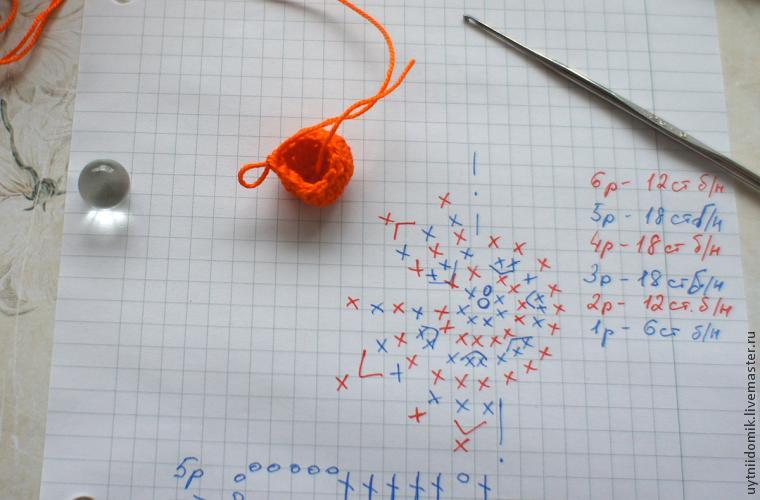 We put into our “cap” the tail that sticks out from the beginning of knitting and the ball – he enters with difficulty, but still gives in, but will not fall out when knitting the next row.
We put into our “cap” the tail that sticks out from the beginning of knitting and the ball – he enters with difficulty, but still gives in, but will not fall out when knitting the next row. 7 number: Article w / n in every two columns (Ibaka) – continue until the end of the series and get 6 tablespoons w / n.
7 number: Article w / n in every two columns (Ibaka) – continue until the end of the series and get 6 tablespoons w / n.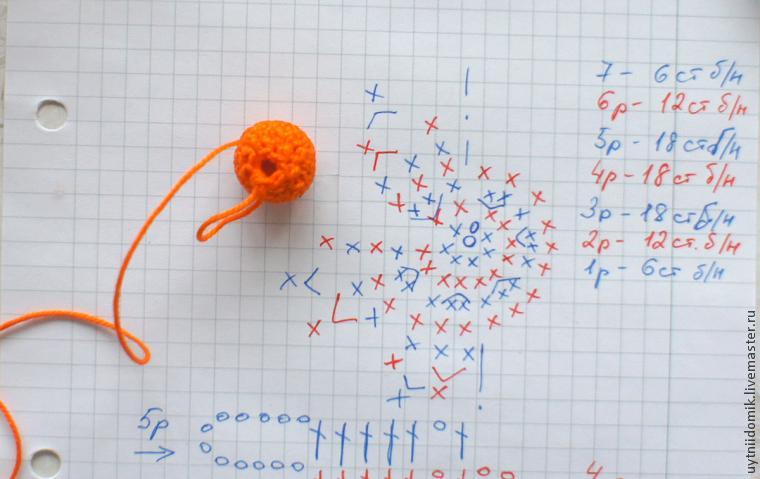 At this point, I usually end up tying the ball. Through Art w / I pull for eyelet – turns 3 loops on the hook – and them together, thereby connecting the edges.
At this point, I usually end up tying the ball. Through Art w / I pull for eyelet – turns 3 loops on the hook – and them together, thereby connecting the edges. Now the thread itself. Try knitting ce tightly and uniformly to the thread of the same length were obtained. Provyazyvaem 40 CE
Now the thread itself. Try knitting ce tightly and uniformly to the thread of the same length were obtained. Provyazyvaem 40 CE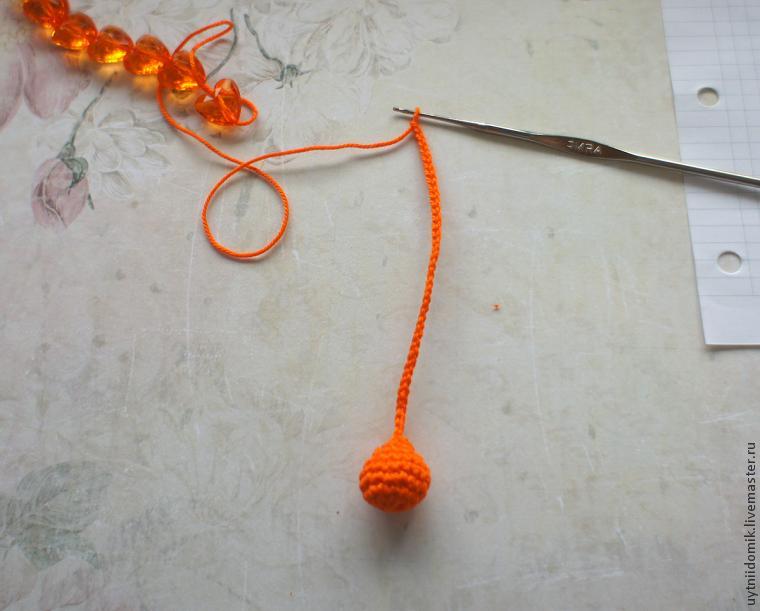 Provyazyvaem another 2 CP and item b / n the 2nd ce off the hook – get neat “knot”, which will hold the bead.
Provyazyvaem another 2 CP and item b / n the 2nd ce off the hook – get neat “knot”, which will hold the bead. The height of the beads is equal to 5 V. – Provyazyvaem 5 CP
The height of the beads is equal to 5 V. – Provyazyvaem 5 CP Slightly pull the loop and with the help of the hook through the hole stretch her beads.
Slightly pull the loop and with the help of the hook through the hole stretch her beads.
 From beads sticking only half ce Waist loop to normal size, and continue knitting.
From beads sticking only half ce Waist loop to normal size, and continue knitting. Again 40 ce, 2 ce with Article w / n, 5 CP, and bead.
Again 40 ce, 2 ce with Article w / n, 5 CP, and bead.
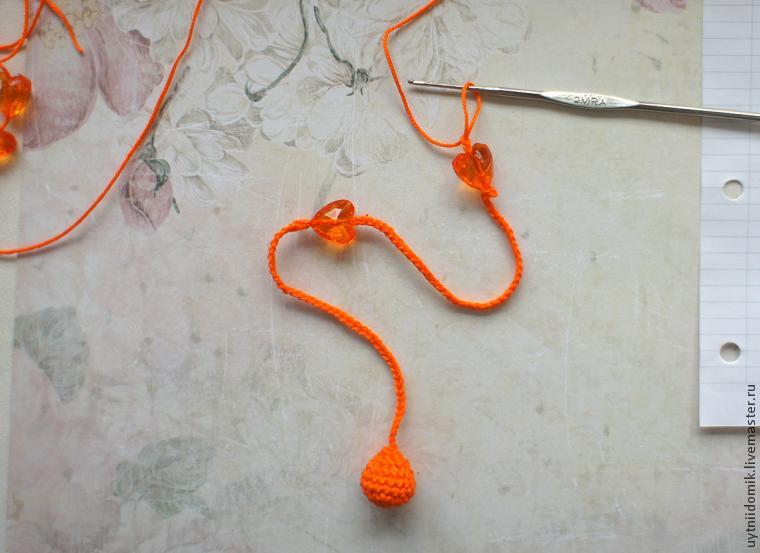
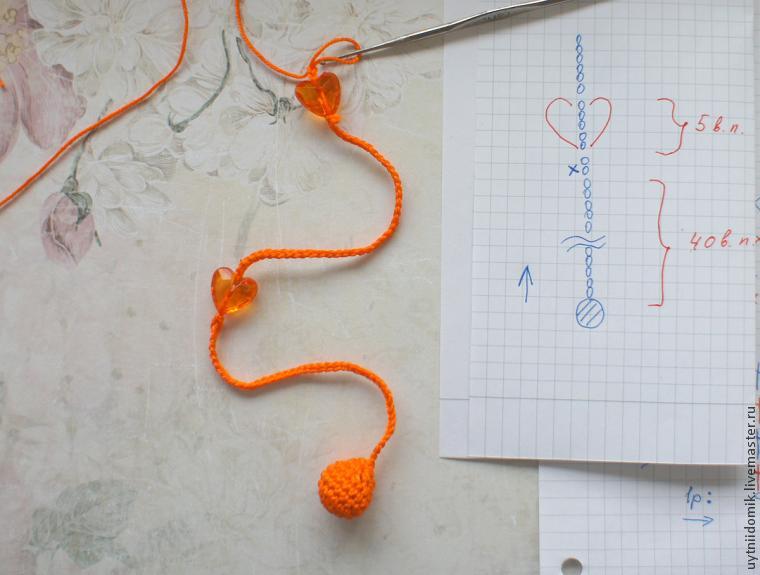
So keep knitting until the end strung beads, and after the last bead 40 ce, cut the thread and leave the tip length of 6-8 cm, which would be possible to tie a thread to the “eyelet” tape.
All yarn knit similarly. To edge is slightly wavy and more interesting, each second thread after the last I do not provyazyvala beads 40 CP and 20 CP As a result, half of yarn turned out a little shorter.
Tie the thread to the band tails and hide.
Shutters are ready.

Beautiful curtains made of beads and artificial flowers
Such air and colorful curtains to make very simple of beads and artificial flowers, and they look very original. So here’s what we need to work:
So here’s what we need to work:
To begin with, the line cut off the required length (required length multiplied by two, and add another 30 cm).
In the middle of the fishing line put large beads and folded twice the line begin to string beads.
 Thread the fishing line through the heart of the flower., Then re-stringing beads. We continue to alternate colors and beads until there is 15 cm of line.
Thread the fishing line through the heart of the flower., Then re-stringing beads. We continue to alternate colors and beads until there is 15 cm of line. So do the required number of threads. For mounting use wooden batten desired length, the holes drilled in it at a distance of about 10 cm from each other. You’re ready to tie the thread to the rail and our original floral curtain is ready!
So do the required number of threads. For mounting use wooden batten desired length, the holes drilled in it at a distance of about 10 cm from each other. You’re ready to tie the thread to the rail and our original floral curtain is ready!


